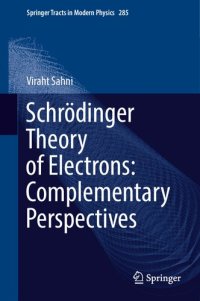
Ebook: Schrödinger Theory of Electrons: Complementary Perspectives
Author: Viraht Sahni
- Year: 2022
- Publisher: Springer Nature Switzerland
- Language: English
- pdf
About this book
This book presents a complementary perspective to Schrödinger theory of electrons in an electromagnetic field, one that does not appear in any text on quantum mechanics. The perspective, derived from Schrödinger theory, is that of the individual electron in the sea of electrons via its temporal and stationary-state equations of motion – the ‘Quantal Newtonian’ Second and First Laws. The Laws are in terms of ‘classical’ fields experienced by each electron, the sources of the fields being quantum-mechanical expectation values of Hermitian operators taken with respect to the wave function. Each electron experiences the external field, and internal fields representative of properties of the system, and a field descriptive of its response. The energies are obtained in terms of the fields. The ‘Quantal Newtonian’ Laws lead to physical insights, and new properties of the electronic system are revealed. New mathematical understandings of Schrödinger theory emerge which show the equation to be intrinsically self-consistent. Another complimentary perspective to Schrödinger theory is its manifestation as a local effective potential theory described via Quantal Density Functional theory. This description too is in terms of ‘classical’ fields and quantal sources. The theory provides a rigorous physical explanation of the mapping from the interacting system to the local potential theory equivalent. The complementary perspective to stationary ground state Schrödinger theory founded in the theorems of Hohenberg and Kohn, their extension to the presence of a magnetic field and to the temporal domain – Modern Density Functional Theory -- is also described. The new perspectives are elucidated by application to analytically solvable interacting systems. These solutions and other relevant wave function properties are derived.
About the author
Viraht Sahni received his Bachelor of Technology (Honors) degree in Electrical Engineering from the Indian Institute of Technology, Bombay, India, in 1965, his Master of Science in Electrical Engineering (1968) and his Doctor of Philosophy in Physics (1972) from the Polytechnic Institute of Brooklyn, New York, USA. He was a post-doctoral associate at Brooklyn College of the City University of New York (CUNY) from 1972-1974, when he joined Brooklyn College as Assistant Professor and Member of the doctoral faculty in Physics of the Graduate Centre of CUNY. He became (and is presently) Professor of Physics at Brooklyn College and the Graduate Centre of CUNY in 1982. He was Visiting Research Physicist at the National (now Kavli) Institute of Theoretical Physics, Santa Barbara, California, in 1983. He was appointed Broeklundian Professor of Physics at Brooklyn College from 2001–2011. His interests lie in the theoretical foundations of and applications to the electronic structure of matter, both natural and artificial. He has published three books on a newly developed theory of electronic structure: Quantal Density Functional Theory, Springer-Verlag, 2004; Quantal density Functional Theory II: Approximation Methods and Applications, Springer-Verlag, 2010, and Quantal density Functional Theory, 2nd Edition, Springer-Verlag, 2016.